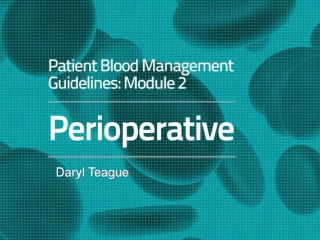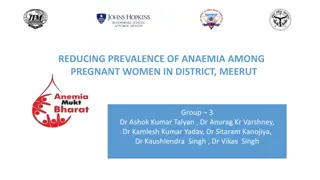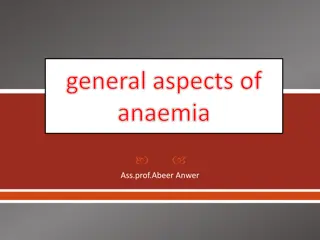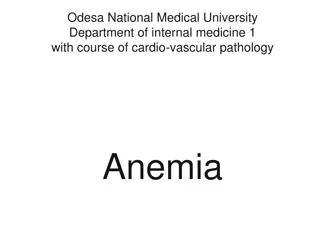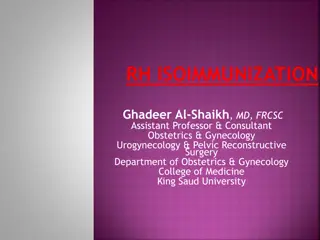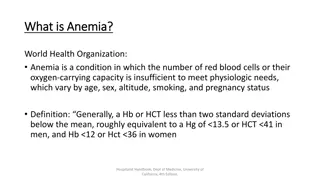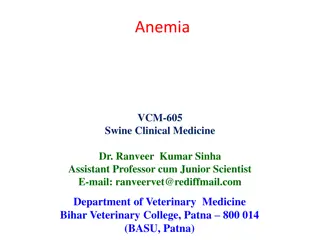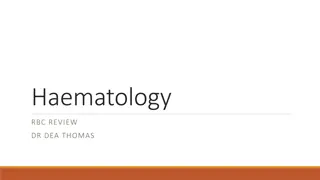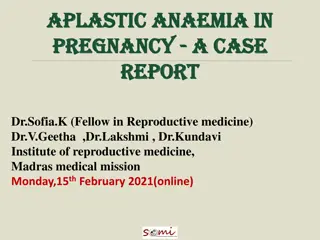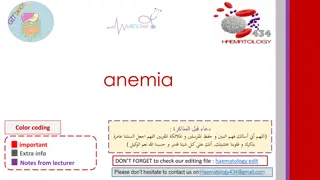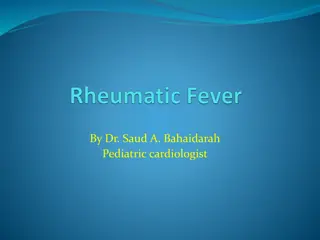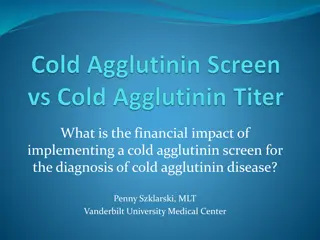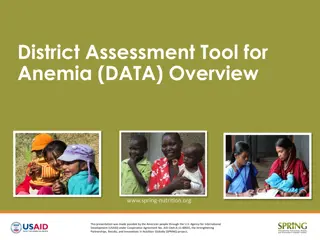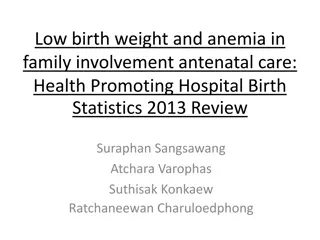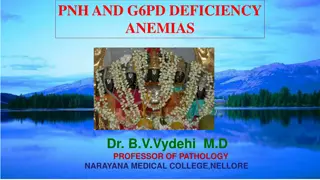Understanding Hemolytic Anemia: Classification and Management
Hemolytic anemia encompasses various subtypes like autoimmune hemolytic anemia, with warm and cold antibodies, each requiring unique management strategies. Diagnosis involves specific investigations like the Coombs test. Treatment typically involves corticosteroids as first-line therapy, while second-line options include immunosuppression and splenectomy. Cold agglutinin disease is another notable subtype. Understanding the classification and management of hemolytic anemia is crucial for effective patient care.
Download Presentation

Please find below an Image/Link to download the presentation.
The content on the website is provided AS IS for your information and personal use only. It may not be sold, licensed, or shared on other websites without obtaining consent from the author. Download presentation by click this link. If you encounter any issues during the download, it is possible that the publisher has removed the file from their server.
E N D
Presentation Transcript
Autoimmune haemolytic anaemia This results from increased red cell destruction due to red cell autoantibodies. The antibodies may be IgG or IgM, or more rarely IgE or IgA. If an antibody avidly fixes complement, it will cause intravascular haemolysis, but if complement activation is weak, the haemolysis will be extravascular (in the reticulo-endothelial system).
Warm antibodies bind best at 37C and account for 80% of cases. the majority are IgG and often react against Rhesus antigens. Cold antibodies bind best at 4 C but can bind up to 37 C in some cases. They are usually IgM and bind complement. To be clinically relevant, they must act within the range of normal body temperatures. They account for the other 20% of cases.
Investigations : General : Specific : The standard Coombs reagent will miss IgA or IgE antibodies. Around 10% of all warm autoimmune haemolytic anaemias are Coombs test- negative.
Management warm type If the haemolysis is secondary to an underlying cause, this must be treated and any implicated drugs stopped.
1stline treatment prednisolone (1 mg/kg orally). A response is seen in 70 80% of cases but may take up to 3 weeks; a rise in haemoglobin will be matched by a fall in bilirubin, LDH and reticulocyte levels. Once the haemoglobin has normalised and the reticulocytosis resolved, the glucocorticoid dose can be reduced slowly over several weeks. Q Glucocorticoids probably work by..?
2ndline : These include immunomodulation/suppression and splenectomy. Currently, there are fewer splenectomies than previously and the second-line drug of choice in current UK guidance is the anti-CD20 monoclonal antibody rituximab. Splenectomy is associated with a good response in 50 60% of cases. The operation can be performed laparoscopically with reduced morbidity. If splenectomy is not appropriate, alternative immunosuppressive therapy with azathioprine, ciclosporin.
Cold agglutinin disease This is mediated by antibodies, usually IgM, which bind to the red cells at low temperatures and cause them to agglutinate
This can be chronic when the antibody is monoclonal ..lymphoma or acute or transient when the antibody is polyclonal infection .
Chronic cold agglutinin disease This typically affects elderly patients and may be associated with an underlying low- grade B-cell lymphoma. It causes a low- grade intravascular haemolysis with cold, painful and often blue fingers, toes, ears or nose (so-called acrocyanosis).
Other causes of cold agglutination Cold agglutination can occur in association with Mycoplasma pneumoniae or with infectious mononucleosis
Treatment : Treat the underlying cause : infection , lymphoma . Warm the peripheries in winter . less likely steroid /rituximab .
Alloimmune haemolytic anaemia unmatched blood transfusion maternal sensitisation to paternal antigens on fetal cells. (haemolytic disease of the newborn,
Non-immune haemolytic anaemia 1-Endothelial damage: Mechanical heart valves. March haemoglobinuria. Thermal injury. Microangiopathic haemolytic anaemia.
2-Infection Plasmodium falciparum malaria may be associated with intravascular haemolysis; when severe, this is termed blackwater fever because of the associated haemoglobinuria Clostridium perfringens sepsis usually in the context of ascending cholangitis or necrotising fasciitis .
3-Chemicals or drugs Dapsone and sulfasalazine. Benzine Nitrate . Arsenic.
Paroxysmal nocturnal haemoglobinuria rare acquired,non immune non-malignant clonal expansion of haematopoietic stem cells deficient in glycosylphosphatidylinositol (GPI) anchor protein which is important to protect the cell against the complement mediated hemolysis. ..complement activation
Clinical features : Hemolysis. Thrombosis at unusual sites ..liver /abdomen . Aplastic an./MDS
TREATMENT : Supportive .. Anti complement C5 Ab ECULIZUMAB.


